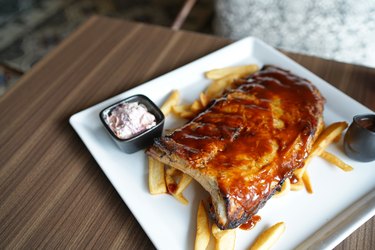
There's just something about a rack of ribs that makes you want to sit outside at a checkered picnic table and get messy. But let's face it, when it comes to ribs nutrition, they're probably not going to be topping any healthy food lists any time soon. But what about a half rack?
Although a half rack of ribs is smaller than a full rack, it's still a pretty large portion. Typically, a full rack of ribs averages 10 to 13 ribs that are 3 to 6 inches long and weigh about 1 1/2 to 2 pounds. That means a half rack would fall somewhere around five to six ribs and weigh 12 to 16 ounces.
Video of the Day
Video of the Day
Read more: How to Cook Pork Ribs on a Propane Grill
Ribs Calories, Fat and Protein
A half rack of ribs (that weighs 12 ounces) contains about 549 calories. Around 297 of those calories come directly from fat. A half rack of ribs contains 33 grams of total fat and 12 of those grams (or about 36 percent) are in the form of saturated fat. While this may alarm you a little bit, the narrative on saturated fat has changed, although the there's still a lot of debate about its health effects.
While an August 2017 report published in Annual Review of Nutrition says that replacing saturated fat with unsaturated fats can lower your risk of heart disease, a September 2018 review in Current Nutrition Reports claims that there appears to be no connection between lowering saturated fat intake and a reduced risk of death from heart disease (or any other cause).
That being said, the goal is to focus on overall diet quality. Rather than focusing on simply eliminating saturated fat, it's better to look at the diet as a whole and focus on avoiding processed foods and simple carbohydrates and increasing your intake of fresh, whole foods.
While all meat provides protein, baby back ribs are loaded. You'll get 63 grams of high-quality protein in a half rack of ribs. Your exact protein needs depend on how much you weigh, but a general rule is 0.8 grams per kilogram of body weight, according to Harvard Health Publishing. According to these guidelines, if you weigh 150 pounds, you need 55 grams of protein per day. If you weigh in at 200 pounds, your protein needs go up to 73 grams.
Keep in mind that if you're active, you're trying to build muscle or change your body composition, your protein needs will likely be higher. This is a minimum recommendation that you can play around with to find your sweet spot.
Carbs in Baby Back Ribs
Like most meats, baby back ribs don't contain any carbohydrates or fiber. Of course, this applies to a half rack of ribs without any sauces or fixins. The carbs will be considerably different for a half rack of baby back ribs that are smothered in barbecue sauce, especially if that barbecue sauce is loaded with sugar (which many are).
Adding 1/2 cup of pre-bottled barbecue sauce to your half rack of ribs will add 58 total carbohydrates and a whopping 47.5 grams of sugar. That's more added sugar than the American Heart Association recommends for the entire day (36 grams for men and 25 grams for women).
Instead of using sugary barbecue sauce, you make your ribs a better option by seasoning it with a dry rub instead. This will give it a lot of smoked flavor without the added carbohydrates or sugar. You can also make your own barbecue sauce so you can control the amount of sugar that goes into it.
In addition to the macros for baby back ribs, you may also be interested in which vitamins and minerals you'll get from a half rack. Meat is actually very nutrient dense and a 12-ounce half rack of baby back ribs will give you:
- 87 milligrams of calcium
- 2.8 milligrams of iron
- 900 milligrams of potassium
- 315 milligrams of sodium
- USDA FoodCentral Data: "Baby Back Ribs"
- USDA FoodCentral Data: "Sauce, Barbecue"
- Kitchn: "What’s the Difference Between Baby Back Ribs and Spareribs?"
- Current Nutrition Reports: "Saturated Fat: Part of a Healthy Diet"
- American Heart Association: "Added Sugars"
- Harvard Health Publishing: "How Much Protein Do You Need Every Day?"
- Annual Review of Nutrition: "Dietary Fat and Risk of Cardiovascular Disease: Recent Controversies and Advances"